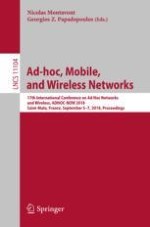2018 | Buch
Ad-hoc, Mobile, and Wireless Networks
17th International Conference on Ad Hoc Networks and Wireless, ADHOC-NOW 2018, Saint-Malo, France, September 5-7, 2018. Proceedings
herausgegeben von: Nicolas Montavont, Georgios Z. Papadopoulos
Verlag: Springer International Publishing
Buchreihe : Lecture Notes in Computer Science


